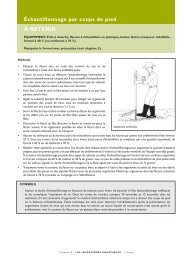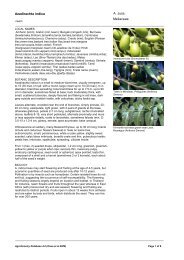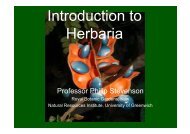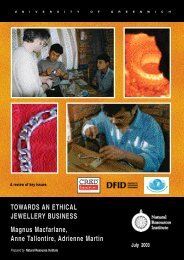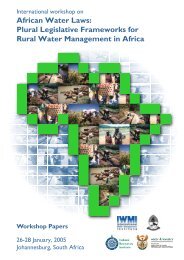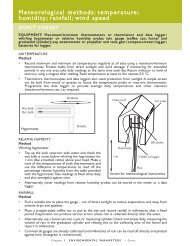botanical insecticides, deterrents, and repellents in modern ...
botanical insecticides, deterrents, and repellents in modern ...
botanical insecticides, deterrents, and repellents in modern ...
You also want an ePaper? Increase the reach of your titles
YUMPU automatically turns print PDFs into web optimized ePapers that Google loves.
Annu. Rev. Entomol. 2006.51:45-66. Downloaded from arjournals.annualreviews.org<br />
by University of British Columbia Library on 12/09/05. For personal use only.<br />
54 ISMAN<br />
as <strong><strong>in</strong>secticides</strong>. In spite of the patents based on the <strong>in</strong>secticidal activities of these<br />
materials, no commercial development has proceeded with the exception of a head<br />
lice shampoo that conta<strong>in</strong>s a st<strong>and</strong>ardized pawpaw extract among its active <strong>in</strong>gredients<br />
(Nature’s Sunsh<strong>in</strong>e Products, Inc., United States). Annona seed extracts may<br />
prove more useful <strong>in</strong> tropical countries where the fruits are commonly consumed<br />
or used to produce fruit juice, <strong>in</strong> which case the seeds are a waste product. For<br />
example, Leatemia & Isman (59, 60) recently demonstrated that crude ethanolic<br />
extracts or even aqueous extracts of seeds from A. squamosa collected at several<br />
sites <strong>in</strong> eastern Indonesia are effective aga<strong>in</strong>st the diamondback moth (Plutella<br />
xylostella).<br />
Sucrose Esters<br />
In the early 1990s scientists at the U.S. Department of Agriculture discovered that<br />
sugar esters naturally occurr<strong>in</strong>g <strong>in</strong> the foliage of wild tobacco (Nicotiana gossei)<br />
were <strong>in</strong>secticidal to certa<strong>in</strong> soft-bodied <strong>in</strong>sects <strong>and</strong> mites. Although patented (75),<br />
extraction of these substances on a commercial scale from plant biomass proved<br />
impractical, lead<strong>in</strong>g to the development of sucrose esters manufactured from sugar<br />
<strong>and</strong> fatty acids obta<strong>in</strong>ed from vegetable oils. AVA Chemical Ventures (United<br />
States) has patented <strong>and</strong> registered an <strong>in</strong>secticide/miticide based on C8 <strong>and</strong> C10 fatty<br />
acid mono-, di-, <strong>and</strong> triesters of sucrose octanoate <strong>and</strong> sucrose dioctanoate (31).<br />
The product, first registered <strong>in</strong> 2002, conta<strong>in</strong>s 40% active <strong>in</strong>gredient. Functionally,<br />
this product appears to differ little from the <strong>in</strong>secticidal soaps based on fatty<br />
acid salts developed <strong>in</strong> the 1980s, particularly potassium oleate. Both products<br />
are contact <strong><strong>in</strong>secticides</strong> that kill small <strong>in</strong>sects <strong>and</strong> mites through suffocation (by<br />
block<strong>in</strong>g the spiracles) or disruption of cuticular waxes <strong>and</strong> membranes <strong>in</strong> the<br />
<strong>in</strong>tegument, lead<strong>in</strong>g to desiccation. Although useful <strong>in</strong> home <strong>and</strong> garden products<br />
<strong>and</strong> <strong>in</strong> greenhouse production, the utility of these materials for agriculture rema<strong>in</strong>s<br />
to be seen.<br />
Melia Extracts<br />
The remarkable bioactivity of azadiracht<strong>in</strong> from the Indian neem tree (Azadirachta<br />
<strong>in</strong>dica) led to the search for natural <strong><strong>in</strong>secticides</strong> <strong>in</strong> the most closely related genus,<br />
Melia. Seeds from the ch<strong>in</strong>aberry tree, M. azedarach, conta<strong>in</strong> a number of triterpenoids,<br />
the meliacarp<strong>in</strong>s (Figure 2), that are similar but not identical to the<br />
azadiracht<strong>in</strong>s, <strong>and</strong> these too have <strong>in</strong>sect growth regulat<strong>in</strong>g bioactivities (58). But <strong>in</strong><br />
spite of the abundance of ch<strong>in</strong>aberry trees <strong>in</strong> Asia <strong>and</strong> other tropical <strong>and</strong> subtropical<br />
areas to which they were <strong>in</strong>troduced, development of commercial <strong><strong>in</strong>secticides</strong><br />
has not paralleled that of the neem <strong><strong>in</strong>secticides</strong>. The ma<strong>in</strong> reason is the presence,<br />
<strong>in</strong> ch<strong>in</strong>aberry seeds, of additional triterpenoids, the meliatox<strong>in</strong>s, that have<br />
demonstrated toxicity to mammals (4). However the chemistry of ch<strong>in</strong>aberry varies<br />
considerably across its natural <strong>and</strong> <strong>in</strong>troduced range, <strong>and</strong> seeds of M. azedarach<br />
grow<strong>in</strong>g <strong>in</strong> Argent<strong>in</strong>a lack meliatox<strong>in</strong>s but produce triterpenoids (most notably



